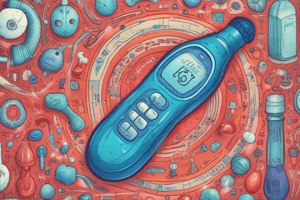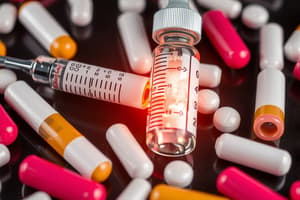Podcast
Questions and Answers
What is the typical characteristic of Diabetic Ketoacidosis?
What is the typical characteristic of Diabetic Ketoacidosis?
- Absence of ketonuria and presence of metabolic acidosis
- Presence of ketonuria and absence of metabolic acidosis
- Presence of ketonemia and metabolic acidosis (correct)
- Absence of ketonemia and metabolic acidosis
What is the primary cause of coma in Hyperosmolar Coma?
What is the primary cause of coma in Hyperosmolar Coma?
- Ketonemia
- Cellular dehydration in the brain (correct)
- Hypoglycemia
- Metabolic acidosis
What is the common symptom of Hypoglycemia and Hyperglycemia?
What is the common symptom of Hypoglycemia and Hyperglycemia?
- Blurred vision (correct)
- Polydipsia
- Nausea and vomiting
- Polyphagia
What is the cause of Leukocytosis in Diabetic Ketoacidosis?
What is the cause of Leukocytosis in Diabetic Ketoacidosis?
What is the typical characteristic of Hyperglycemia in Diabetic Ketoacidosis?
What is the typical characteristic of Hyperglycemia in Diabetic Ketoacidosis?
What is the cause of hyperosmolality in Hyperosmolar Coma?
What is the cause of hyperosmolality in Hyperosmolar Coma?
What is the characteristic of Kussmaul breathing in Diabetic Ketoacidosis?
What is the characteristic of Kussmaul breathing in Diabetic Ketoacidosis?
What is the characteristic laboratory finding in steatohepatitis due to alcohol-related fatty liver disease?
What is the characteristic laboratory finding in steatohepatitis due to alcohol-related fatty liver disease?
Which of the following is a risk factor for the development of nonalcoholic fatty liver disease (NAFLD)?
Which of the following is a risk factor for the development of nonalcoholic fatty liver disease (NAFLD)?
What is the characteristic histopathological feature of micronodular cirrhosis?
What is the characteristic histopathological feature of micronodular cirrhosis?
What is the consequence of decreased production of adiponectin by adipocytes in NAFLD?
What is the consequence of decreased production of adiponectin by adipocytes in NAFLD?
What is the characteristic clinical feature of steatosis due to alcohol-related fatty liver disease?
What is the characteristic clinical feature of steatosis due to alcohol-related fatty liver disease?
What is the consequence of insulin resistance in NAFLD?
What is the consequence of insulin resistance in NAFLD?
What is the characteristic laboratory finding in steatosis due to nonalcoholic fatty liver disease?
What is the characteristic laboratory finding in steatosis due to nonalcoholic fatty liver disease?
What is the consequence of activation of inflammasome in NAFLD?
What is the consequence of activation of inflammasome in NAFLD?
Study Notes
Regulation of Insulin Secretion
- Glucose is the primary physiologic stimulant of insulin release, entering β cells via glucose transporter (GLUT 2)
- Glucokinase, an enzyme regulated by glucose, controls the first step in glucose metabolism
- Stimulators of insulin release include:
- Vagal stimulation
- β-adrenergic stimulation
- GLP1
- Amino acids
- Inhibitors of insulin release include:
- Catecholamines
- α-adrenergic stimulation
- Somatostatin
Diabetes Mellitus
- Defined as a heterogeneous disorder characterized by hyperglycemia
- Criteria for diagnosis:
- Fasting plasma glucose ≥ 126 mg/dL (7.0 mmol/L)
- Symptoms of DM plus a random plasma glucose ≥ 200 mg/dL (11.1 mmol/L)
- Plasma glucose ≥ 200 mg/dL after OGTT
- Classification:
- Normal fasting plasma glucose: 70-99 mg/dL (3.4-5.5 mmol/L)
- Impaired fasting glucose (IFG): 100-125 mg/dL (5.6-6.9 mmol/L)
- Impaired glucose tolerance (IGT): plasma glucose 140-199 mg/dL (7.8-11 mmol/L) after 2-hour OGTT
- Prediabetes: IFG or IGT
- Diabetes: symptoms of hyperglycemia and casual plasma glucose ≥ 200 mg/dL (11.1 mmol/L)
Etiology of Diabetes Mellitus
- Functional deficiency of insulin action → hyperglycemia
- Decreased insulin secretion by β cells of pancreas (DM 1)
- Decreased response to insulin by target tissues → insulin resistance (DM 2)
- Increase in counterregulatory hormones that oppose the effects of insulin (DM in endocrinopathies, gestational DM)
Types of Diabetes Mellitus
- Type I DM
- Selective destruction of over 90% of pancreatic β cells with severe insulin deficiency
- Immune-mediated (autoimmune DM 1) → 90%
- Idiopathic → 10%
- Type II DM
- Insulin resistance with relative insulin deficiency
- Genetic predisposition stronger than in DM 1
- Polygenic origin of disease
- Gestational Diabetes Mellitus (GDM)
- Any hyperglycemic state that occurs or is recognized for the first time during pregnancy
- Occurs in 4% of pregnant women
- May recur with subsequent pregnancies (in ~30%)
- Tends to resolve at parturition
- Associated with obesity
Complications of Diabetes Mellitus
-
Acute Complications
- Diabetic ketoacidosis
- Hyperosmolar coma
- Hypoglycemia
-
Chronic Complications
- Macrovascular:
- Atherosclerosis
- Stroke
- Heart disease
- Hypertension
- Microvascular:
- Retinopathy
- Nephropathy
- Neuropathy### Morphology of Steatofibrosis/Cirrhosis
- Macrovascular:
-
Gross findings: nodular surface, greenish color
-
Microscopic findings:
- Central vein sclerosis
- Perisinusoidal scarring
- Central portal fibrous septa
- Continual subdivision of nodules (micronodular cirrhosis)
- With abstinence, regeneration occurs, forming macronodules
Clinical Features of Alcohol-Related Fatty Liver Disease
Steatosis
- Asymptomatic, but may present with hepatomegaly
- Mild increase in serum bilirubin and alkaline phosphatase
- Resolves with abstinence
Steatohepatitis
- Weeks to months of heavy alcohol consumption
- Possible acute onset
- Symptoms: malaise, anorexia, tender hepatomegaly, fever
- Laboratory findings:
- Hyperbilirubinemia
- Increased serum alkaline phosphatase
- AST & ALT < 500 U/mL
- AST : ALT > 2:1
- Increased risk of cirrhosis and death
Chronic Liver Failure/Cirrhosis
Pathogenesis of NAFLD
- Contributing factors:
- Diabetes type II
- Central obesity
- Dyslipidemia (high TG & LDL, low HDL)
- Hypertension
- Mechanisms:
- Insulin resistance → increased activity of lipoprotein lipase → increased release of free fatty acids
- Decreased production of adiponectin by adipocytes
- Decreased oxidation of FFA by skeletal muscle
- Increased uptake of FFA by hepatocytes
- Activation of inflammasome (release of IL-1)
- Products of lipid metabolism → hepatocytes injury → stellate cell activation → fibrosis
Clinical Features of NAFLD
- Transaminase elevation (AST : ALT < 1)
- Steatosis: usually asymptomatic
- Steatohepatitis: asymptomatic or presents with fatigue, malaise, discomfort in right upper quadrant
- Low progression to NASH / cirrhosis
Studying That Suits You
Use AI to generate personalized quizzes and flashcards to suit your learning preferences.
Related Documents
Description
This quiz covers the regulation of insulin secretion, including the role of glucose, glucokinase, and stimulators of insulin release in diabetes mellitus.




